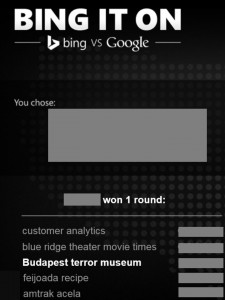
Who doesn't love a side-by-side taste test? You get to choose for yourself - awesome! For me, the ultimate taste test is the Pepsi Challenge (Pepsi Cola vs. Coca-Cola), a key feature of the "Cola Wars" since 1975. It's very simple and very effective - even for the audience. So for tech giant Microsoft to take on the dominant search engine Google with it's own Bing search engine, the side-by-side test drive opportunity at the heart of the "Bing it On" campaign was a natural.
It should be no surprise that the Bing it On campaign was planned for multi-screen execution, which I found to be fascinating. Well, the marketing lessons from Microsoft's Bing it On campaign apply to any multichannel scenario, so here are the four main lessons I learned:
Map the customer journey.
Starting and ending with the customer seems so basic, but it's critically important if you want to be effective across multiple channels. Here are some tips for making it happen:
- Physically map out the multiple exit and entry points.
- Rationalize your calls to action in context of the overall goal. And understand that the same call to action on every channel is not necessarily the right move. For each channel, try to find the sweet spot - the overlap of what the customer wants to do and what you want them to do.
- Ensure the right content is served up in the right place. Again - it may not be the same content or the same format in every channel. This is especially true if your website is not mobile optimized.
Develop the content plan.
The goal of a well-planned content plan is to enable a coordinated customer conversation. Each part should reinforce the campaign message and support the overall goal. Tips for a good content plan include:
- Using the customer journey map, plan content so the story develops across the channels.
- At each step, customer context has to shape the message. Be attentive to what are they doing when they get the message and how might they be more receptive.
- For your social strategy, it has to engage people in the conversation they’re already having – and the Bing it On team, for example, was sensitive to the Final Four.
- For mobile, the challenge is understanding how the user is using the device. One nice idea for Bing it On was to give people the option to “remind me to take the challenge later.”
Involve the analytics team at every step.
Bring your analytics team in at the beginning - when you are mapping out the customer journey. Then keep them involved along the way, because they can help you formulate the right questions so you get the answers you actually need. Specifically, take a test-and-learn approach to optimize ROI and be ready to capture incremental gains when they happen. Then apply them going forward.
This idea of getting the analytics team involved at the beginning is a key success factor at office supplies giant Staples, per Jim Foreman, Director of Circulation and Analytics at Staples. Click here to read a quick succes story about how Staples is driving success with marketing analytics - and Jim Foreman and his team get involved from the beginning of every campaign.
Foster a culture that delivers intended results.
Marketing is always a team sport, frequently including key team members in many other areas of the organization. Knowing that, be attuned to your organizational culture within and among work teams and keep the following tips in mind:
-
A collaborative culture starts with breaking out of siloes, so find ways to get your team to think outside their siloes and align to an overarching marketing goal.
-
Drive operational rigor across disciplines - this is key because execution is what drives the customer experience. If you want a specific experience, you have to orchestrate that outcome.
-
Invest in supporting lasting cultural change. It doesn’t happen overnight, or even after just a few meetings. For the Bing it On team, one strong catalyst was simply having shout-outs to foster team support and recognition. Find what works for your team and your situation.
For another view on the importance of culture in marketing, download this whitepaper by Argyle Executive Forums called Building a Marketing Analytics Culture, featuring an interview with Adele Sweetwood, VP of Americas Marketing at SAS.
------------
Karen Starns, General Manager of Consumer Marketing for Bing/MSN at Microsoft, spoke at the 2013 Masters of Marketing Conference of the Association of National Advertisers – an event SAS is proud to be a sponsor of, and an organization that SAS is proud to be a member of.

2 Comments
Pingback: Google Sell-Side ‘Active GRP’ Coming Soon; Crossing Devices
Hi there, I check your new stuff on a regular basis. Your humoristic style
is witty, keep up the good work!